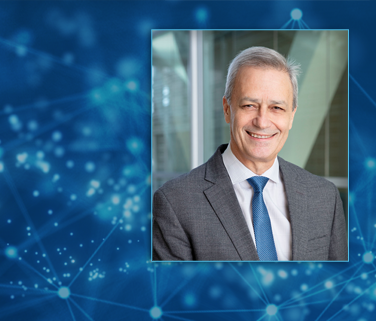While the current healthcare model is focused on treating and curing serious illnesses like cancer, heart disease and osteoporosis, Amgen is advocating for a different approach: one aimed at predicting who is at risk and helping to prevent the impact of serious diseases from occurring.
We recently talked to Amgen's chief medical officer, Dr. Darryl Sleep, about why the company champions this approach and how progress towards improving public health can be accelerated by working together with like-minded partners.
Why is prevention important, and what does it mean to focus on predicting and preventing diseases?
I've given this a lot of thought in my three years at Amgen. Essentially it is better to prevent serious illnesses or poor outcomes than try and manage them once they occur.
The first thing we ask with this approach is, “What can we do to identify individuals who are at increased risk for serious illness?” That's the predict part.
Then, “What can we do to intervene early enough to avoid, minimize or eliminate the poor outcomes?” That's the prevent part.
Cardiovascular disease, for example, is the most common health problem among American adults. We know a lot about the risk factors that make individuals more susceptible, such as high cholesterol. We also know a lot can be done first to mitigate those factors and then to intervene early to help prevent poor outcomes, whether it's a heart attack, stroke or hospitalization.
Encouraging and increasing screening to identify the risk factors for severe illness and initiating effective preventive measures early, when treatment is most likely to be effective, can reduce the significant negative impact of these diseases.
Why is a collaborative approach needed to address these public health challenges?
The short answer is no individual or group can do it alone. These are major challenges, and the only way we're going to tackle them effectively is by working together. We all have the shared objectives of reducing the impact of serious illness and improving the wellbeing of our communities, and we all bring different but complementary skills to the table. Collectively, we can make a significant difference.
Can you tell us about some of the collaborative programs that Amgen is involved in?
We have great examples of multi-stakeholder programs that I feel honored to be a part of.
The CDC Foundation’s Alliance for the Million Hearts®, is working toward preventing 1 million heart attacks and strokes through multiple educational campaigns. In 2020, the CDC Foundation led a public service announcement to spotlight the importance of heart health and seeking medical care during COVID-19. More recently, we joined the Foundation in launching “Start Small. Live Big.” to promote simple steps adults can take to protect their heart health. An upcoming campaign will focus on educating adults at an earlier age when prevention is still possible, particularly those in the African American community who are hardest hit by cardiovascular disease.
Amgen also works with the CDC Foundation on EmPOWERed Health to educate and inspire people to be more proactive about cancer prevention, screening and treatment.
The Susan G. Komen and American Bone Health initiative is another example. This three-year program educates women about their evolving risk for breast cancer, bone loss and fracture and encourages screening.
We also recently launched a pilot program with Quest/Walmart Joint Venture that offers bone density screenings for eligible older adults in stores at no cost. This program integrates prevention into an everyday activity, making screening more accessible.
All of these programs help empower patients so they feel more in control of their health, which means they will be more likely to go for screenings and to engage in shared decision-making with their healthcare teams—both of which can lead to better outcomes.
Why is Amgen committed to this work and what value does Amgen bring to the table?
As an MD and a member of the healthcare community, I feel we have an obligation to improve the lives of the patients who live with the conditions for which we have developed innovative medicines. Treatment with our medicines is an integral part of a broader medical solution for patients, and we also have a role to play in improving health and wellbeing across the board. I take that responsibility very seriously.
Our collaborative efforts focus on the disease areas for which we have a deep expertise. Our role extends beyond financial support for these initiatives to lending this expertise and sharing connections across our networks—from academic and community clinical settings to professional societies and patient advocacy organizations—to help make the biggest possible impact.
True collaboration also requires moving beyond perceived conflicts to recognize we each have something to contribute. We've been able to help break down those barriers through these programs to foster stronger collaborations to the benefit of patients.
What’s your vision of the future based on the possibility of what multi-stakeholder collaborations can bring to the world?
The real value of these programs is to identify the at-risk individuals, increase awareness of their risks and their treatment options and intervene early enough that we’re preventing severe undesirable outcomes. Downstream, this would mean fewer heart attacks, strokes, falls, fractures and emergency room visits as well as decreased occurrences of cancer. That’s the objective. Our work might never be done, but that's a dream worth chasing. It's like the Yorkshire Terrier running after the London bus. You might not ever catch it, but you're never going to stop trying.





